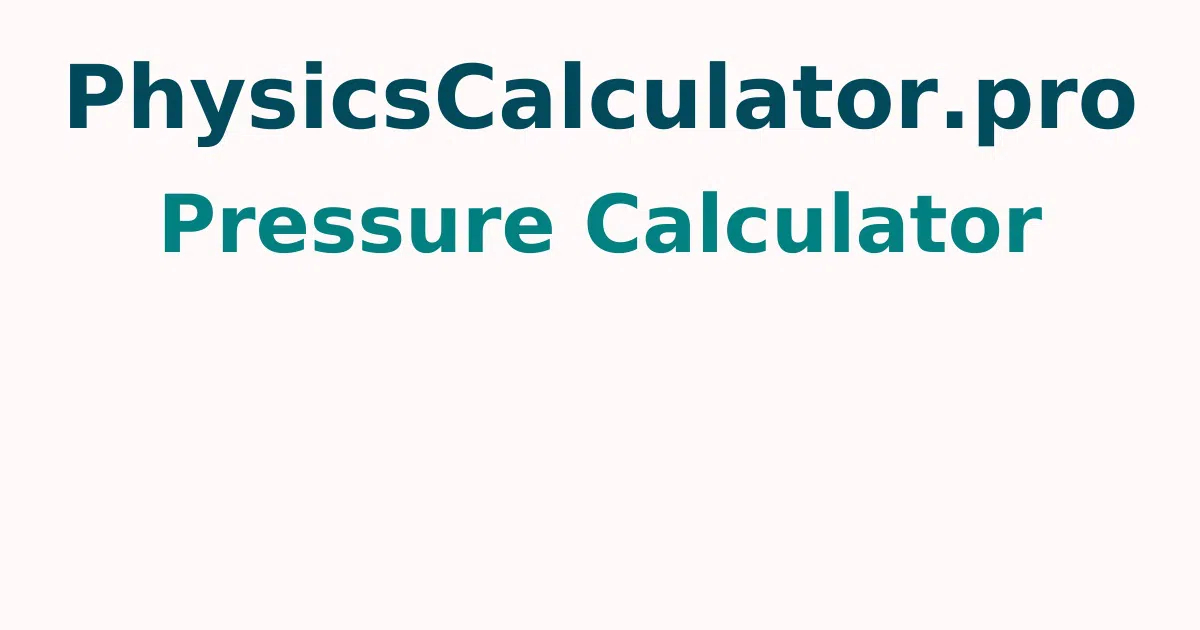Pressure Calculator
With the pressure calculator that we have built for you, you as a user can calculate the pressure which is exerted in regard by a force on a specific area of a surface.
What is meant by Pressure?
As previously defined, pressure is a physical quantity that describes the magnitude of a force distributed perpendicularly on the surface of an object. There are different types of pressure due to the source of its origin of force per unit area. These are, for example
- Aerostatic pressure also called the pressure in gases, this is the pressure inside the gas arising from its own weight.
- Hydrostatic pressure similar to aerostatic pressure this pressure is in liquids and is arisen from the weight of the liquid.
- Acoustic pressure a small deviation from the average value of atmospheric pressure, occurring during the propagation of an acoustic wave in it is called Acoustic pressure, it is similar to the pressure produced in the waves of the musical instruments as well.
Pressure Formula
The pressure calculator that is developed by us uses the standard scientific pressure formula below
P = F/A
- Where: P is the pressure,
- F is the force and
- A is the area of the surface
This pressure definition relates to the force that is applied perpendicularly to the surface of the object considering its length per unit area. The pressure is a physical scalar quantity which means that it has no direction (unlike the force which is a vector quantity).
Pressure Measurement
A plethora of techniques has already been developed for the measurement of pressure, from labs to easily feasible instruments. Such instruments that measure and display pressure are called pressure gauge instruments. Usually, any pressure related measurements are made relative to some specific pressure reference, and generally, we take atmospheric pressure as the standard reference. We thus have
- Absolute pressure which is zero-referenced against a perfect vacuum in the environment,
- Gauge pressure which is zero-referenced against ambient air pressure of the environment (it can be easily calculated as absolute pressure minus atmospheric pressure)
- Differential pressure is zero-referenced against any other, specific values of pressure.
What is Standard Pressure?
The recently used values of standard pressure depend on the committees and are usually 100 kPa or 101.325 kPa, which is approximately 14.5 or 14.7 psi. Standard pressure is the value of pressure defined by scientific and metrological organizations to allow comparisons between different experimental results in the same conditions.
How to Calculate Pressure?
The procedure to use for finding pressure is simple and is as follows
- Investigate which physical entity generates the pressure. Is it an object, liquid, or air?
- Find the force that the source of pressure exerts on a certain surface and which is perpendicular to the surface.
- Find the area of that surface.
- Do check if both values are in the correct units, i.e., newtons/meters squared or pounds/inches squared.
- Use the formula and divide the force by the area.
- Your pressure will be expressed in pascals (Pa) which is the standard unit or pounds per square inch (psi).
For more concepts check out physicscalculatorpro.com to get quick answers by using this free tool.
How to use the Pressure Calculator?
The procedure to use the pressure calculator is as it is described here
- Step 1: Enter the force, area for the unknown in the respective input field in our calculator.
- Step 2: Now click the button “Solve” to get the pressure value within seconds.
- Step 3: Finally, the pressure on the object will be displayed in the output field with Pascal as its standard unit.
FAQs on Pressure Calculator
1. What is the Standard Unit of Pressure?
The Standard Unit of Pressure is Pascal.
2. What is Standard Pressure?
Standard pressure is the value of pressure defined by scientific and metrological organizations which is 100 kPa or 101.325 kPa.
3. What are different types of pressure?
The different types of Pressure are Osmotic Pressure, Hydrostatic Pressure, Aerostatic Pressure.
